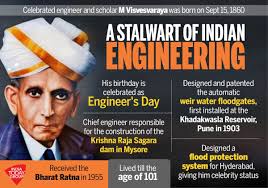The Engineering Community across India celebrates Engineers Day on 15 September, every year as a tribute to the greatest Indian Engineer.
Sir Mokshagundam Visvesvaraya KCIE FASc, more commonly known as Sir MV, was an Indian civil engineer and statesman and the 19th Diwan of Mysore, serving from 1912 to 1919. He received India’s highest honour, the Bharat Ratna, in 1955.
Long before Jawaharlal Nehru conjured up visions of ‘temples’ for modern India, Visvesvaraya had already built one. As the chief engineer of Mysore, he conceived and supervised the construction of the Krishna Raja Sagara Dam on the Cauvery, India’s largest river valley project at the time. The project was by no means a cakewalk: the dam’s construction required the approval of the Maharaja of Mysore, Krishna Raja Wadiyar, his diwan, Ananda Rao, and officials of the British empire, including Lord Hardinge, the viceroy, and his resident in Mysore, Sir Hugh Daly.
The whole enterprise was politically fraught and financially overwhelming: at one point Visvesvaraya threatened to quit if the Maharaja did not approve the dam, as well as other pending projects. The king relented. What made this skilled engineer a powerful technocrat, and why did his ideas bite the dust in independent India?

Visvesvaraya grew into an unsentimental man of action, leaving for greener academic pastures in Bengaluru soon after the untimely death of his father. He did have to earn his keep: while an uncle gave him breakfast and meals, board and college fees came from a wealthy local family. It was in service of this household that our future Bharat Ratna launched his career, giving private tuition to prosperous children long before he won his knighthood and came to be called India’s Father of Economic Planning.
The almost 101 years “Sir MV” lived were full of work and unceasing activity. He wrote books and gave countless speeches.
He worshipped fact alone, caring little for oratorical wit or the charms of rhetoric. The keystone of his existence was routine and grinding discipline—the story went that he wore a three-piece suit (plus turban) even for a walk in his garden.
When he spoke, his words came pregnant with substance, and he travelled the world—from America to Japan—commenting on everything from urban drainage to women’s employment.
He loved statistics with a passion and published Reconstructing India in 1920,.

He set up MYSORE UNIVERSITY, and pumped money into the KRISHNA RAJA SAGARA DAM. He established the BANK OF MYSORE and set in motion what would become the IRON AND STEEL WORKS IN BHADRAVATI. From developing the SANDALWOOD SOAP INDUSTRY to promoting SILKS FROM MYSORE’S LOOMS, Visvesvaraya soon proved himself the force behind a thriving state, resigning only after six years, following a quarrel with the maharajah on the issue of reservations.
He sat on the board of the Tata Iron and Steel Co. and served as president of the Indian Science Congress. He lambasted the British for their economic exploitation, even as he lectured his countrymen against making fatalistic philosophical excuses. In 1934, he argued even with Gandhi—the Mahatma did not share Visvesvaraya’s faith in large-scale industry, noting that “we hold perhaps diametrically opposite views”
He once said, “The curse of our country is laziness. At first sight everyone seems to be working. But in fact, one man works and the others watch him. As someone said with contempt, ‘it looks as if five men are working. But really only one man works. One man will be doing nothing. One man will be resting. Another man will be watching them. Yet another man will be helping these three.”
- Sir Visvesvaraya was dedicated to work. He was also a man of spotless honesty.
- He was credited for the construction of a system that was beneficial for flood protection in Hyderabad. Later his techniques proved successful to make Vishakhapatnam port soil erosion free.
- He was responsible for bringing out certain effective irrigation techniques especially in the Deccan region.
- He designed aromatic barrier, water flood gates and drainage system.
- He encouraged girls to attend schooling and also set up an agricultural university.
- He set up a sandal oil factory


